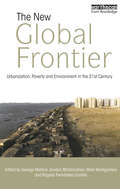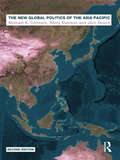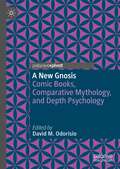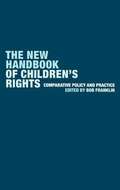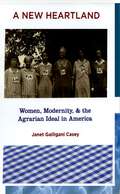- Table View
- List View
New Ghosts, Old Ghosts: Prisons and Labor Reform Camps in China (Socialism And Social Movements Ser.)
by James D. Seymour Michael R AndersonMuch has been written about the laogai (sometimes likened to the Soviet gulag) in the People's Republic of China. Depending on the source, the prisons are described as nonexistent, enlightened institutions, or hellish places that subject the inmates to degradation and misery. The system is commonly thought of (by admirers and critics alike) as having a measurable impact on the national economy and providing significant resources to the state. Based on research in classified documents and extensive interviews with former prisoners, judicial personnel, and other insiders, and featuring case studies dealing with the three northwestern provinces, this book examines such assertions on the basis of the facts about this underexamined subject in order to arrive at a detailed, objective, and realistic picture of the situation. In the case of each province under study, the authors discuss the history of the provincial prison system and the impact that each has had at the macro, meso, and micro levels.
The New Gilded Age: The Critical Inequality Debates of Our Time (Studies in Social Inequality)
by David Grusky Tamar Kricheli-KatzIncome inequality is an increasingly pressing issue in the United States and around the world. This book explores five critical issues to introduce some of the key moral and empirical questions about income, gender, and racial inequality: Do we have a moral obligation to eliminate poverty? Is inequality a necessary evil that's the best way available to motivate economic action and increase total outpt? Can we retain a meaningful democracy even when extreme inequality allows the rich to purchase political privilege? Is the recent stalling out of long-term declines in gender inequality a historic reversal that presages a new gender order? How are racial and ethnic inequalities likely to evolve as minority populations grow ever larger, as intermarriage increases, and as new forms of immigration unfold? Leading public intellectuals debate these questions in a no-holds-barred exploration of our New Gilded Age.
The New Global Frontier: Urbanization, Poverty and Environment in the 21st Century
by George Martine Gordon McGranahan Mark Montgomery Rogelio Fernandez-CastillaThe world?s developing countries will be experiencing massive increases in their urban populations over the 21st century. If managed intelligently and humanely, this growth can pave the way to sustainable development; otherwise, it will favour higher levels of poverty and environmental stress. The outcome depends on decisions being made now. The principal theme that runs through this volume is the need to transform urbanization into a positive force for development. Part I of this book reviews the demography of the urban transition, stressing the importance of benefi cial rural-urban connections and challenging commonly held misconceptions. Part II asks how urban housing, land and service provision can be improved in the face of rapid urban expansion, drawing lessons from experiences around the world. Part III analyses the challenges and opportunities that urbanization presents for improving living environments and reducing pressures on local and global ecosystems. These social and environmental challenges must be met in the context of fast-changing demographic circumstances; Part IV explores the range of opportunities that these transformations represent. These challenges and opportunities vary greatly across Africa, Asia and Latin America, as detailed in Part V. Published with IIED and UNFPA
The New Global Frontier: Urbanization, Poverty and Environment in the 21st Century
by George Martine Gordon McGranahan Mark Montgomery Rogelio Fernandez-CastillaThe world?s developing countries will be experiencing massive increases in their urban populations over the 21st century. If managed intelligently and humanely, this growth can pave the way to sustainable development; otherwise, it will favour higher levels of poverty and environmental stress. The outcome depends on decisions being made now. The principal theme that runs through this volume is the need to transform urbanization into a positive force for development. Part I of this book reviews the demography of the urban transition, stressing the importance of benefi cial rural-urban connections and challenging commonly held misconceptions. Part II asks how urban housing, land and service provision can be improved in the face of rapid urban expansion, drawing lessons from experiences around the world. Part III analyses the challenges and opportunities that urbanization presents for improving living environments and reducing pressures on local and global ecosystems. These social and environmental challenges must be met in the context of fast-changing demographic circumstances; Part IV explores the range of opportunities that these transformations represent. These challenges and opportunities vary greatly across Africa, Asia and Latin America, as detailed in Part V. Published with IIED and UNFPA
The New Global Politics of the Asia Pacific
by Michael K. Connors Rémy Davison Jörn DoschThe new, fully updated second edition of The New Global Politics of the Asia Pacific builds on its coherent framework for understanding the complex international and global politics of the Asia Pacific. The textbook provides an introductory guide for the main frameworks needed to understand the region (realism, liberalism, critical theory), which is reader-friendly while still offering sophisticated competing interpretations. Key content includes: the US in the Asia Pacific; China and Japan in the Asia Pacific; Southeast Asia in the Asia Pacific; India in the Asia Pacific; Russia in the Asia Pacific; Australia in the Asia Pacific; Europe in the Asia Pacific; globalization, regionalism and political economy; Asian values, democracy and human rights; transnational actors; region security order and the impact of terrorism on the region. ? A highly topical account, which provides an overview of the main actors, institutions and contemporary issues such as security, terrorism and transnational actors, the book is required reading for undergraduate students of Asian studies, international politics, and anyone interested in the region.
The New Global Politics of the Asia Pacific
by Michael K. Connors Rémy Davison Jörn DoschThe new, fully updated second edition of The New Global Politics of the Asia Pacific builds on its coherent framework for understanding the complex international and global politics of the Asia Pacific. The textbook provides an introductory guide for the main frameworks needed to understand the region (realism, liberalism, critical theory), which is reader-friendly while still offering sophisticated competing interpretations. Key content includes: the US in the Asia Pacific; China and Japan in the Asia Pacific; Southeast Asia in the Asia Pacific; India in the Asia Pacific; Russia in the Asia Pacific; Australia in the Asia Pacific; Europe in the Asia Pacific; globalization, regionalism and political economy; Asian values, democracy and human rights; transnational actors; region security order and the impact of terrorism on the region. ? A highly topical account, which provides an overview of the main actors, institutions and contemporary issues such as security, terrorism and transnational actors, the book is required reading for undergraduate students of Asian studies, international politics, and anyone interested in the region.
The New Global Politics of the Asia-Pacific: Conflict and Cooperation in the Asian Century
by Michael K. Connors Rémy Davison Jörn DoschNow in its new and fully updated third edition, The New Global Politics of the Asia Pacific continues to provide a compelling analysis of a region undergoing dramatic changes. Based on new research and offering fresh interpretation, this edition evaluates the prospects for continuing US dominance in the ‘Asian Century’. Whilst presenting evidence for a multifaceted ‘Beijing Strategy', which aims to counter the US by building an alternative regional order, it also explains Japan’s definitive departure from its limited military role. Providing an introductory guide for the main frameworks needed to understand the region, including realism, liberalism and critical theory, this new edition is reader-friendly, and offers sophisticated competing explanations. Key content includes: Intra-regional conflicts in the South China Sea and the Korean peninsula, The different responses within the Asia-Pacific to the globalization of Western ideas of democracy and political economy, The underappreciated success of the Association of Southeast Asian Nations in building a regional identity, The European Union’s soft power in the region. A highly topical account, which offers an overview of the main actors, institutions and contemporary issues in the Asia-Pacific, the book will be essential reading for undergraduate students of Asian Studies, International Politics, and anyone interested in the region.
The New Global Politics of the Asia-Pacific: Conflict and Cooperation in the Asian Century
by Michael K. Connors Rémy Davison Jörn DoschNow in its new and fully updated third edition, The New Global Politics of the Asia Pacific continues to provide a compelling analysis of a region undergoing dramatic changes. Based on new research and offering fresh interpretation, this edition evaluates the prospects for continuing US dominance in the ‘Asian Century’. Whilst presenting evidence for a multifaceted ‘Beijing Strategy', which aims to counter the US by building an alternative regional order, it also explains Japan’s definitive departure from its limited military role. Providing an introductory guide for the main frameworks needed to understand the region, including realism, liberalism and critical theory, this new edition is reader-friendly, and offers sophisticated competing explanations. Key content includes: Intra-regional conflicts in the South China Sea and the Korean peninsula, The different responses within the Asia-Pacific to the globalization of Western ideas of democracy and political economy, The underappreciated success of the Association of Southeast Asian Nations in building a regional identity, The European Union’s soft power in the region. A highly topical account, which offers an overview of the main actors, institutions and contemporary issues in the Asia-Pacific, the book will be essential reading for undergraduate students of Asian Studies, International Politics, and anyone interested in the region.
A New Gnosis: Comic Books, Comparative Mythology, and Depth Psychology (Contemporary Religion and Popular Culture)
by David M. OdorisioSuperhero phenomena exploded into 20th- and 21st-century popular culture by way of the visual medium of comic books. In an increasingly secular (yet spiritual) culture that has largely renounced “the gods” (and even religion), what does the return of the superhero through our own pop cultural mythologies say to us—or even about us? This collection of essays from leading and up-and-coming scholars in the fields of comparative mythology and depth psychology considers the return of the superhero as representative of our own unique emergent modern mythology: a wildly diverse pantheon that reflects back to us our most far-reaching hopes and (im)possible (super)human desires. In placing the interpretive tools of comparative mythology and depth psychology alongside the comic book phenomenon, a super-powered palette emerges that unveils the hidden potential of modern readers’ own heightened imaginations. The essays in this anthology examine select comic book and superhero characters from the “Silver Age” 1960s through contemporary 21st-century adaptations and innovations, as readers are invited to discover and uncover what the (re)emergence of these perennial gods and goddesses have to say about our own secret super selves today.
New Great Game in the Indo-Pacific: Rediscovering India’s Pragmatism and Paradoxes
by Bawa Singh Aslam Khan Parvaiz Ahmad Thoker Mansoor Ahmad LoneThis book looks at the emerging power dynamics in the Indo-Pacific region and locates India and its interests within the overarching geostrategic framework. With US and China emerging as leading players within the region, the book analyses the challenges to India’s foreign policy in the face of new alliances, counter-alliances, and great power equations that have formed after the Cold War. It discusses important issues such as China’s strategic forays in the Indian Ocean, the balance of power between countries, India’s Act East opportunities, Russia’s re-engagement in the region, the South China Sea dispute, India’s maritime strategy, and the conundrum of the Quadrilateral Security Dialogue facing India. A comprehensive study of the changing geopolitical and geostrategic environment of the Indo-Pacific region, the book will be an essential read for scholars and researchers of international relations, global politics, foreign policy, maritime studies, Chinese studies, South Asian studies, geopolitics, and strategic studies.
New Great Game in the Indo-Pacific: Rediscovering India’s Pragmatism and Paradoxes
by Bawa Singh Aslam Khan Parvaiz Ahmad Thoker Mansoor Ahmad LoneThis book looks at the emerging power dynamics in the Indo-Pacific region and locates India and its interests within the overarching geostrategic framework. With US and China emerging as leading players within the region, the book analyses the challenges to India’s foreign policy in the face of new alliances, counter-alliances, and great power equations that have formed after the Cold War. It discusses important issues such as China’s strategic forays in the Indian Ocean, the balance of power between countries, India’s Act East opportunities, Russia’s re-engagement in the region, the South China Sea dispute, India’s maritime strategy, and the conundrum of the Quadrilateral Security Dialogue facing India. A comprehensive study of the changing geopolitical and geostrategic environment of the Indo-Pacific region, the book will be an essential read for scholars and researchers of international relations, global politics, foreign policy, maritime studies, Chinese studies, South Asian studies, geopolitics, and strategic studies.
The New Handbook of Children's Rights: Comparative Policy and Practice
by Bob FranklinThe new edition of this well established handbook provides up-to-date information on a topic of increasing importance across a range of disciplines and practices. It covers: * the debate concerning children's rights and developments in rights provision over the last twenty years * the impact of recent British legislation on children's rights in key areas such as education, social and welfare services and criminal justice * the key provisions of the UN Convention and Human Rights Act * recent policy proposals and initiatives in the British setting intended to establish and promote rights for children and young people * the rights claims of particular groups of children, for example children who are carers or children who are disabled * children's claims for particular rights such as the right to space, to sex education and citizenship * the ways in which the voices of children and young people are or might be articulated more clearly in policy debates and other arenas * issues and developments in Europe, Scandinavia and China. The New Handbook of Children's Rightsoffers a comprehensive and radical appraisal of the field which will be invaluable to students and professionals alike.
The New Handbook of Children's Rights: Comparative Policy and Practice
by Bob FranklinThe new edition of this well established handbook provides up-to-date information on a topic of increasing importance across a range of disciplines and practices. It covers:* the debate concerning children's rights and developments in rights provision over the last twenty years* the impact of recent British legislation on children's rights in key areas such as education, social and welfare services and criminal justice* the key provisions of the UN Convention and Human Rights Act* recent policy proposals and initiatives in the British setting intended to establish and promote rights for children and young people* the rights claims of particular groups of children, for example children who are carers or children who are disabled* children's claims for particular rights such as the right to space, to sex education and citizenship* the ways in which the voices of children and young people are or might be articulated more clearly in policy debates and other arenas* issues and developments in Europe, Scandinavia and China.The New Handbook of Children's Rights offers a comprehensive and radical appraisal of the field which will be invaluable to students and professionals alike.
The New Handbook of Children's Rights: Comparative Policy and Practice
by Bob FranklinThe new edition of this well established handbook provides up-to-date information on a topic of increasing importance across a range of disciplines and practices. It covers:* the debate concerning children's rights and developments in rights provision over the last twenty years* the impact of recent British legislation on children's rights in key a
The New Health Bioeconomy: R&D Policy and Innovation for the Twenty-First Century
by James MittraThis book provides new insights into how new biology, and the emergence of "translational" policies to drive the health bioeconomy, is reshaping the innovation ecosystem for new therapies. A key argument is that a broader definition of value (beyond the economic aspects) is needed to understand health innovation in the twenty-first century.
A New Heartland: Women, Modernity, and the Agrarian Ideal in America
by Janet Galligani CaseyModernity and urbanity have long been considered mutually sustaining forces in early twentieth-century America. But has the dominance of the urban imaginary obscured the importance of the rural? How have women, in particular, appropriated discourses and images of rurality to interrogate the problems of modernity? And how have they imbued the rural-traditionally viewed as a locus for conservatism-with a progressive political valence? Touching on such diverse subjects as eugenics, reproductive rights, advertising, the economy of literary prizes, and the role of the camera, A New Heartland demonstrates the importance of rurality to the imaginative construction of modernism/modernity; it also asserts that women, as objects of scrutiny as well as agents of critique, had a special stake in that relation. Casey traces the ideals informing America's conception of the rural across a wide field of representational domains, including social theory, periodical literature, cultural criticism, photography, and, most especially, women's rural fiction ("low" as well as "high"). Her argument is informed by archival research, most crucially through a careful analysis of The Farmer's Wife, the single nationally distributed farm journal for women and a little known repository of rural American attitudes. Through this broad scope, A New Heartland articulates an alternative mode of modernism by challenging orthodox ideas about gender and geography in twentieth-century America.
A New Heartland: Women, Modernity, and the Agrarian Ideal in America
by Janet Galligani CaseyModernity and urbanity have long been considered mutually sustaining forces in early twentieth-century America. But has the dominance of the urban imaginary obscured the importance of the rural? How have women, in particular, appropriated discourses and images of rurality to interrogate the problems of modernity? And how have they imbued the rural-traditionally viewed as a locus for conservatism-with a progressive political valence? Touching on such diverse subjects as eugenics, reproductive rights, advertising, the economy of literary prizes, and the role of the camera, A New Heartland demonstrates the importance of rurality to the imaginative construction of modernism/modernity; it also asserts that women, as objects of scrutiny as well as agents of critique, had a special stake in that relation. Casey traces the ideals informing America's conception of the rural across a wide field of representational domains, including social theory, periodical literature, cultural criticism, photography, and, most especially, women's rural fiction ("low" as well as "high"). Her argument is informed by archival research, most crucially through a careful analysis of The Farmer's Wife, the single nationally distributed farm journal for women and a little known repository of rural American attitudes. Through this broad scope, A New Heartland articulates an alternative mode of modernism by challenging orthodox ideas about gender and geography in twentieth-century America.
The New Helots: Migrants in the International Division of Labour (Routledge Revivals)
by Robin CohenOriginally published in 1987 and now reissued with a substantial introduction by Robin Cohen, this wide-ranging work of comparative and historical sociology argues that a major engine of capital’s growth lies in its ability to find successive cohorts of quasi-free workers to deploy in the farms, mines and factories of an expanding international division of labour. These workers, like the helots of ancient Greece, are found at the periphery of ‘regional political economies’ or in the form of modern migrants, sucked into the vortex of metropolitan service or manufacturing industry. The regions of Southern Africa; the USA and the circum-Caribbean; European and its colonial and southern hinterlands, are systematically compared – yielding original and, in some cases, uncomfortable analogies between countries previously thought to be wholly different in terms of their political structures and guiding values. The New Helots has been written with both an undergraduate and professional readership in mind. Students of history, sociology and economics as well as those interested in patterns of migration and ethnic relations will find it of interest.
The New Helots: Migrants in the International Division of Labour (Routledge Revivals)
by Robin CohenOriginally published in 1987 and now reissued with a substantial introduction by Robin Cohen, this wide-ranging work of comparative and historical sociology argues that a major engine of capital’s growth lies in its ability to find successive cohorts of quasi-free workers to deploy in the farms, mines and factories of an expanding international division of labour. These workers, like the helots of ancient Greece, are found at the periphery of ‘regional political economies’ or in the form of modern migrants, sucked into the vortex of metropolitan service or manufacturing industry. The regions of Southern Africa; the USA and the circum-Caribbean; European and its colonial and southern hinterlands, are systematically compared – yielding original and, in some cases, uncomfortable analogies between countries previously thought to be wholly different in terms of their political structures and guiding values. The New Helots has been written with both an undergraduate and professional readership in mind. Students of history, sociology and economics as well as those interested in patterns of migration and ethnic relations will find it of interest.
New Heritage: New Media and Cultural Heritage
by Yehuda Kalay Thomas Kvan Janice AffleckThe use of new media in the service of cultural heritage is a fast growing field, known variously as virtual or digital heritage. New Heritage, under this denomination, broadens the definition of the field to address the complexity of cultural heritage such as the related social, political and economic issues. This book is a collection of 20 key essays, of authors from 11 countries, representing a wide range of professions including architecture, philosophy, history, cultural heritage management, new media, museology and computer science, which examine the application of new media to cultural heritage from a different points of view. Issues surrounding heritage interpretation to the public and the attempts to capture the essence of both tangible (buildings, monuments) and intangible (customs, rituals) cultural heritage are investigated in a series of innovative case studies.
New Heritage: New Media and Cultural Heritage
by Yehuda Kalay Thomas Kvan Janice AffleckThe use of new media in the service of cultural heritage is a fast growing field, known variously as virtual or digital heritage. New Heritage, under this denomination, broadens the definition of the field to address the complexity of cultural heritage such as the related social, political and economic issues. This book is a collection of 20 key essays, of authors from 11 countries, representing a wide range of professions including architecture, philosophy, history, cultural heritage management, new media, museology and computer science, which examine the application of new media to cultural heritage from a different points of view. Issues surrounding heritage interpretation to the public and the attempts to capture the essence of both tangible (buildings, monuments) and intangible (customs, rituals) cultural heritage are investigated in a series of innovative case studies.
The New Heroines: Female Embodiment and Technology in 21st-Century Popular Culture
by Katheryn WrightThis book explores how the next generation of teen and young adult heroines in popular culture are creating a new feminist ideal for the 21st century.Representations of a teenage girl who is unique or special occur again and again in coming-of-age stories. It's an irresistible concept: the heroine who seems just like every other, but under the surface, she has the potential to change the world. This book examines the cultural significance of teen and young adult female characters—the New Heroines—in popular culture.The book addresses a wide range of examples primarily from the past two decades, with several chapters focusing on a specific heroic figure in popular culture. In addition, the author offers a comparative analysis between the "New Woman" figure from the late 19th and early 20th century and the New Heroine in the 21st century. Readers will understand how representations of teenage girls in fiction and nonfiction are positioned as heroic because of their ability to find out about themselves by connecting with other people, their environment, and technology.
The New Heroines: Female Embodiment and Technology in 21st-Century Popular Culture
by Katheryn WrightThis book explores how the next generation of teen and young adult heroines in popular culture are creating a new feminist ideal for the 21st century.Representations of a teenage girl who is unique or special occur again and again in coming-of-age stories. It's an irresistible concept: the heroine who seems just like every other, but under the surface, she has the potential to change the world. This book examines the cultural significance of teen and young adult female characters—the New Heroines—in popular culture.The book addresses a wide range of examples primarily from the past two decades, with several chapters focusing on a specific heroic figure in popular culture. In addition, the author offers a comparative analysis between the "New Woman" figure from the late 19th and early 20th century and the New Heroine in the 21st century. Readers will understand how representations of teenage girls in fiction and nonfiction are positioned as heroic because of their ability to find out about themselves by connecting with other people, their environment, and technology.
New Higher History: The Scottish Wars of Independence 1249-1328 (PDF)
by Andy MacpheeThe New Higher History series offers a full-colour, topic-based approach to the revised Higher History syllabus. Covering all of the main issues within each topic area, this series includes investigative techniques, use of evidence and a variety of activities to enable students to develop the necessary skills to tackle both essay-based and source-based questions successfully.
New Higher History: The Cold War 1945-1989 (PDF)
by Simon WoodExam Board: SQA Level: Higher Subject: History First Teaching: September 2014 First Exam: June 2015 The only textbook to offer support for the CfE Higher History topic The Cold War 1945-1989 The New Higher History series offers a full-colour, topic-based approach to the CfE Higher History syllabus. Covering all of the main issues within each topic area, this series includes investigative techniques, use of evidence and a variety of activities to enable students to develop the necessary skills to tackle both extended-response and source-based questions successfully. New Higher History: The Cold War 1945-1989 provides comprehensive coverage of this topic offered in Section 3 of the course. The core issues within the topic are fully explored, preparing students for the extended-response questions in the external examination.


